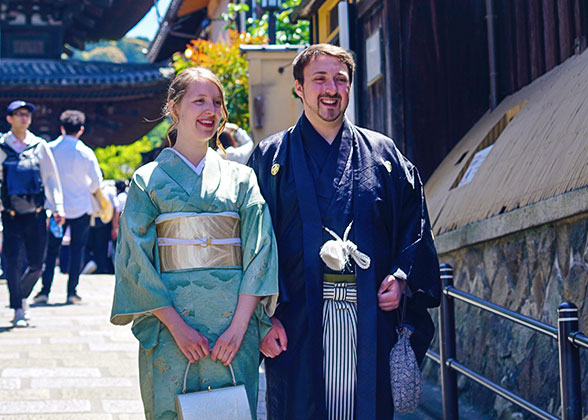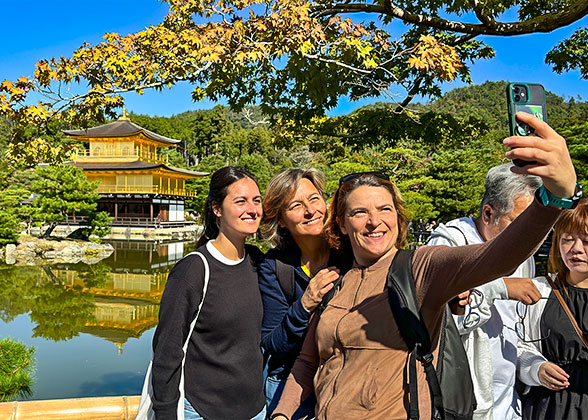Kamo River
Flowing through Kyoto from north to south, Kamo River, or Kamogawa River, gave birth to Kyoto’s history of over a thousand years and nurtures people and creatures that live here. Kamo River to Kyoto is like the River Seine to Paris. It’s not just a river but a carrier of people’s shared memories and a cultural symbol of the city.This river is about 31 km (19 miles) long with breathtaking natural beauty and Japanese style architecture by the riverbank, which make it a good place for people to stroll, date, have a picnic and more. Even the famous writer Haruki Murakami once said that the riverbank of Kamo River is one of the best running places in the world.

Kamo River, or Kamogawa River
|
What to See & Do Along Kamo River
1. Admire Cherry Blossoms in Spring
The beauty of “sakura”, which is cherry blossoms in Japanese, is a highlight of Japan’s natural beauty. Every spring the blossoms paint the riverbank of Kamo River pink and white. Immersing yourself into the picturesque scenery of hazy hills, cherry blossoms and clear water will be a romantic and unforgettable experience. Please note that the best time to enjoy the cherry blossoms is from March to May, and the Flower Corridor near Sanjo Dori Bridge is a good spot.

Kamo River in Spring
|
2. Enjoy Japanese Cuisine & Drinks on Kamogawa Nouryou-Yuka

Women in Kimono by Kamo River
|
3. Hop Across the River on Turtle Stepping Stones
There are a lot of stepping stones on Kamo River with lovely shapes like turtle, cherry blossom, plover, of which the turtle-shaped stepping stones near Kamogawa Delta are the locals’ favorites because Japanese people believe turtles can bring good luck and fortune. It’s of great fun to hop on these stones to cross the river, and you may even meet some fish in the river.Tip: Do not cross the river if it rises in summer, especially when it rains.
4. Simply Relax by the River
It’s an escape from busy life and a relaxation to sit on the grass and breathe some fresh air by Kamo River. People usually also stroll, fish, walk the dog or ride a bike alongside the river. You may buy some food and drinks to have a picnic, watching white egrets flying around and mallards swimming leisurely. All you need to do here is to enjoy. When dusk falls, the dim yellow light and cool breeze will be your unique Kyoto’s memories.
|
|
|
Tip
Kamo River is a long river with many beautiful places to go to, of which the most attractive part is the section from Kamogawa Delta to Gojo Bridge.How to Get to Kamo River
If you intend to enjoy some food or simply relax by the river, you may take a train on Keihan Main Line and get off at Gion-Shijo Station.If you want to experience turtle stepping stones near the Kamogawa Delta, you may take a train on Keihan Main Line and get off at Demachiyanagi Station, walk west and you will see the delta.
Ticket Fare:
Free.
Nearby Attractions
From Gion-Shijo StationPontocho: A historical street to experience geisha culture and Japanese cuisine. You may walk across Shijoo Bridge and walk north for about 1 minute to get there.
Gion District: The birthplace of Japan’s geisha culture and best place to encounter a geisha, in which you could also easily get to Yasaka Shrine - where Japan’s most celebrated festival - Gion Festival originated. You may walk east for 10 minutes to reach Gion District.
From Kamogawa delta or Demachiyanagi Station
Kyoto Imperial Palace: The palace of ancient Japanese emperors before 1868 for a thousand years. You may walk west for about 5 minutes, turn left onto Teramachi-dori and walk for about 10 more minutes to reach it.
You May Like
-
 10 Days Private Tour of Tokyo - Mt. Fuji - Nagoya - Takayama - Shirakawa-go - Kanazawa - Kyoto... from USD3809
10 Days Private Tour of Tokyo - Mt. Fuji - Nagoya - Takayama - Shirakawa-go - Kanazawa - Kyoto... from USD3809 -
 7 Days Mini Group Tour with Essence of Japan: Tokyo - Mt. Fuji - Kyoto - Nara - Osaka from USD2155
7 Days Mini Group Tour with Essence of Japan: Tokyo - Mt. Fuji - Kyoto - Nara - Osaka from USD2155 -
 8 Days Mini Group Tour: Tokyo - Hakone & Mt. Fuji - Kyoto - Nara - Osaka - Hiroshima - Osaka from USD2771
8 Days Mini Group Tour: Tokyo - Hakone & Mt. Fuji - Kyoto - Nara - Osaka - Hiroshima - Osaka from USD2771

